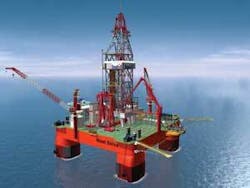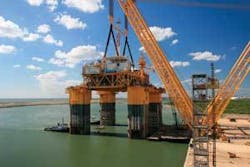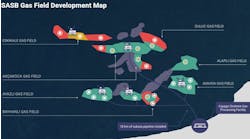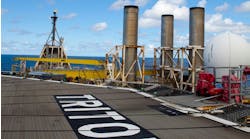David Paganie • Houston
Spotlight on Lower Tertiary play
The Lower Tertiary region in the Gulf of Mexico may hold the largest discovery in North America since Arco (now BP) hit pay on the 9.6-Bbbl Prudhoe Bay oil field on Alaska’s North Slope in 1968. This trend in the GoM, which stretches from Alaminos Canyon to Walker Ridge, is estimated to contain 3-15 Bboe.
According to the MMS, 12 discoveries have been announced in this area from wells drilled 15,000 to 30,000 ft deep.
Lower Tertiary formations, which are estimated to spread 300 mi wide across 3,000 blocks, were deposited from around 65 to 23 million years ago. Reserves contributions from this trend have been negligible prior to these discoveries.
According to the MMS, approximately 99% of the GoM’s proved reserves are located in sediments in less than 23 million years of Miocene age (Upper Tertiary) and younger, while 1% of proved reserves are in older than 65 million year (Jurassic and Cretaceous age) sediments, which are primarily in nearshore areas offshore Louisiana and Alabama.
Industry operators are interested in the Lower Tertiary trend and are bidding high for the opportunity to explore.
Results from the MMS’ Western Gulf Lease Sale 200 in August indicated that 82 tracts received bids in Keathly Canyon, which is nestled between AC and WR containing Paleogene-age reservoirs. The highest bid at the sale was offered by BP at $21 million for KC 58, Petrobras held the second highest bid of $12.8 million for KC 59, and Shell bid $6 million KC 56.
| Prospect | Block | Operator | Discovery date | Water depth (ft) |
|---|---|---|---|---|
| Trident | AC 903 | Chevron | 2001 | 9,687 |
| Great White | AC 857 | Shell | 2002 | 8,009 |
| Cascade | WR 206 | BHP | 2002 | 8,203 |
| Chinook | WR 469 | BHP | 2003 | 8,826 |
| St. Malo | WR 678 | Chevron | 2003 | 6,900 |
| Tobago | AC 859 | Chevron | 2004 | 9,627 |
| Silvertip | AC 815 | Chevron | 2004 | 9,226 |
| Tiger | AC 818 | Chevron | 2004 | 9,004 |
| Jack | WR 759 | Chevron | 2004 | 7,000 |
| Stones | WR 508 | BP | 2005 | 9,576 |
| Gotcha | AC 856 | Total | 2006 | 7,600 |
| Kaskida | KC 292 | BP | 2006 | 5,860 |
Even though the Paleogene trend is a promising exploration target, there still are many challenges and unknowns left to be confronted before production can begin. For example, a flow test was conducted in the second quarter on the highly publicized Chevron-operated Jack discovery in WR 758, which sustained more than 6,000 b/d of oil representing approximately 40% of the total net pay measured in the well, says Chevron.
However, to get to this point, “it required major investments in seismic imaging and drilling technologies to navigate the salt overlay and tight rock formations that characterize the Lower Tertiary formation in that region of the Gulf,” says Peter Robertson, Chevron vice chairman. “The well test alone represents an investment of more than $100 million dollars.”
Chevron estimates that it will take another year to fully assess the potential flows from the well, and another three to five years after that to build it out and produce first oil. An appraisal well is scheduled to be spud on Jack in 2007.
Another challenge is the lack of processing and export infrastructure in the area. One option is to exploit through use of an FPSO. Petrobras already has announced that it plans to use an FPSO for phase 1 production from the Cascade and Chinook fields in WR. The other option is to expand the Gulf’s pipeline network.
Enterprise Products Partners is doing just that. The company has signed definitive agreements with producers to construct, own, and operate an oil export pipeline to provide gathering services from the BHP Billiton-operated Shenzi field located in the South Green Canyon area.
“The location and design of the new pipeline will also provide us with excess capacity and a competitive advantage to pursue additional opportunities to extend our presence into the newly developing Lower Tertiary play in the Walker Ridge area to the south,” says Robert Phillips, Enterprise president and CEO.
Shenzi pipeline
The Shenzi oil export pipeline will originate at the BHP Billiton-operated Shenzi field in Green Canyon block 653 in 4,300 ft of water, approximately 120 mi off the coast of Louisiana. The 83-mi, 20-in. diameter pipeline will have the capacity to transport up to 230,000 b/d of oil and will connect the field to the Cameron Highway Oil Pipeline and Poseidon Oil Pipeline systems at Enterprise’s Ship Shoal 332B junction platform. Enterprise owns a 50% interest in Cameron Highway and a 36% interest in Poseidon and operates both pipelines.
The Shenzi field is owned by a joint venture comprising BHP Billiton with a 44% interest, Repsol E&P USA Inc. and Hess Corp., each holding a 28% interest. First production from Shenzi is expected in mid-2009.
Devon adds rig for deepwater trend
Devon Energy and partners have drilled four discoveries in the Lower Tertiary trend: Jack, Cascade, Kaskida, and St. Malo. The company has built up a portfolio in the area comprising 19 additional prospects, six of which it operates, and 16 Miocene prospects, five operated by Devon.
To drill and develop its inventory of prospects and discoveries, the company has signed a long-term contract with Seadrill Offshore AS for theWest Sirius semisubmersible. The initial contract term is four years. Devon has the option to extend the term to five or six years. The initial term is valued at approximately $690 million.
West Sirius is scheduled for delivery from Singapore in 2Q08.
West Sirius is designed to drill to 37,500 ft deep in up to 10,000 ft of water. The rig currently is under construction and is scheduled for delivery from Singapore in 2Q08.
Prior to entering into theWest Sirius contract, Devon secured a four-year contract with Diamond Offshore for the Ocean Endeavor semisubmersible. The rig, capable of drilling to 35,000 ft deep in 10,000 ft of water, is being refurbished in Singapore and is scheduled to arrive in the Gulf of Mexico in 2Q07.
“With two deepwater rigs under contract, we will have additional capacity and flexibility to test, appraise and develop multiple prospects in the lower Tertiary and Miocene trends,” says Stephen Hadden, senior VP, Devon E&P. The company plans to conduct additional drilling and begin production from the Cascade discovery in late 2009.
In other deepwater news, BP now says it does not expect first production fromThunder Horse before mid-2008. The company performed a series of tests on the field’s subsea components and determined that due to “metallurgical failures,” all seabed production equipment will need to be replaced. BP says a subsea weld failed when it conducted pre-commissioning tests by pumping water through the system to establish component integrity.
M&A
Energy Partners Ltd. (EPL) and Stone Energy Corp. have agreed to terminate their June 22, 2006 merger agreement, on the heels of an acquisition offer by Woodside subsidiary, ATS Inc. However, it appears EPL is not interested in joining up with ATS either. EPL says that the company is now free to explore strategic alternatives to maximize stockholder value, including the possible sale of the company.
In a statement to the company’s board, EPL said, “While the EPL board believed that the addition of Stone’s complementary properties and assets would have been an excellent strategic fit for us, the board has concluded that the exploration of strategic alternatives is in the best interests of EPL stockholders. The board recommends that EPL’s stockholders reject the unsolicited tender offer of ATS Inc., which the board determined to be inadequate and not in the best interests of EPL’s stockholders.”
In connection with the termination of the merger agreement with Stone, EPL has agreed to pay Stone an $8 million termination payment and EPL and Stone have agreed to release all claims between them relating to the merger agreement.
The $8 million payment represents a $17.6 million discount from the fee that would have been payable by EPL to Stone under certain circumstances.
Meanwhile, foreign companies continue to show interest in exploring the Gulf’s potential. Denmark-based Maersk Inc. subsidiary, Maersk Oil Gulf of Mexico LLC, is making its debut in the GoM, through the establishment of an office in Houston and joint venture agreement with Hess Corp. Under the agreement, Maersk has acquired a 33.33% interest in 93 exploration leases covering a total area of 535,680 acres in the western Gulf in water depths up to 5,000 ft. Hess will retain a 66.67% interest in the leases, and operatorship. At print, the agreement was pending approval by the MMS.
Korea-based Korea National Oil Corp. (KNOC) and Samsung Corp. are building a presence in the Gulf as well. The companies settled on an agreement with Santos USA Corp. to farm-in to a shallow water exploration prospect named Jaguar/Cougar in Texas state waters.
KNOC subsidiary, KNOC USA Corp., will take a 15% to 25% interest, depending on the location of the individual leases. Samsung subsidiary, Samsung Oil & Gas USA Corp., will take a 10% interest in the entire project.
Co-owners in various parts of the Jaguar/Cougar project include US-based Sabco Oil & Gas Corp. and Taiwan-based Opicoil America Inc., a wholly owned subsidiary of Overseas Petroleum and Investment Corp.
Santos USA was originally awarded 100% working interest in leases consisting of over 65,000 acres by the state of Texas. The project, which contains a number of deep gas prospects, is located in water depths of less than 30 m.
Atlantia Offshore has completed integration of the 8,400-ton topside and 10,000-ton hull of its DeepDraft semi for theIndependence Hub development. The operation was carried out quayside at the Kiewit Offshore Services facility in Ingleside, Texas. Following additional hookup and commissioning activities, the semi will be towed to Mississippi Canyon block 920 where it will be moored in 8,000 ft of water. Once installed, the Independence Hub will connect to one 24-in. export gas pipeline and have the capacity to connect to 16 infield flowlines and 12 umbilicals coming from an initial 10 subsea fields. Total designed throughput of the process facility is 1 Bcf/d of gas. Independence Hub is owned 80% by Enterprise Products Partners LP and 20% by Helix Energy Solutions, and will be operated by Anadarko Petroleum Corp., on behalf of the Atwater Valley Producers Group (AVPG). The AVPG is comprised of Anadarko Petroleum, Dominion E&P, Hydro GoM LLC, Devon Energy Corp., and Energy Resources Technology.






